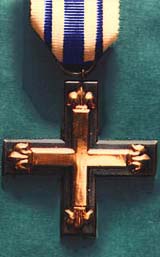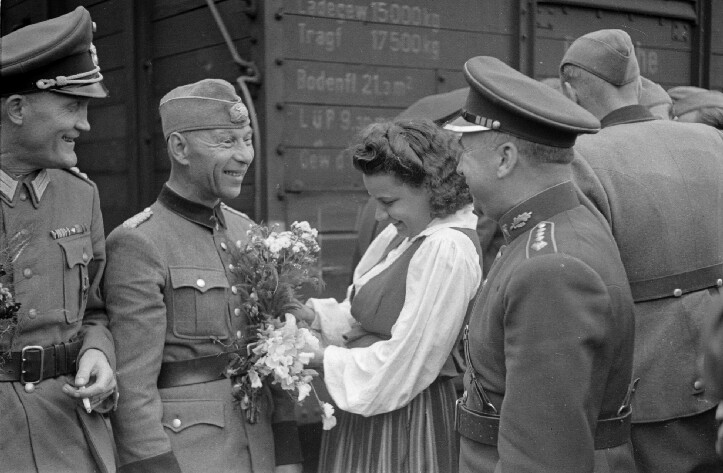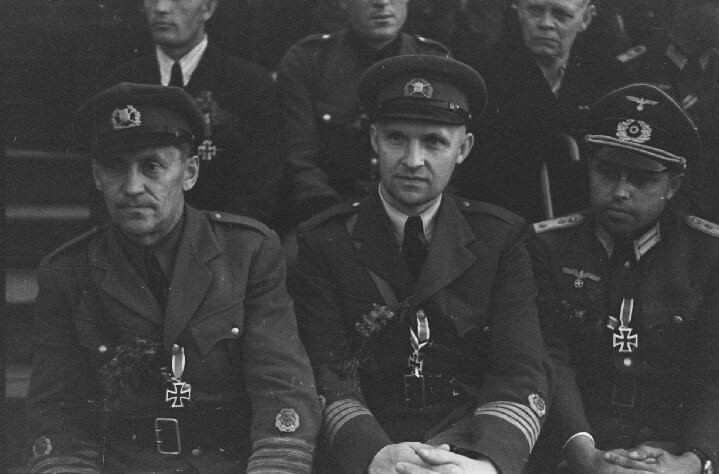Ja huvitav üldse , milliste Eesti autasude ja märkide kandmist sakslane aksepteeris?
Eesti märgid saksa kuuel
Eesti märgid saksa kuuel
Et ohvitserid kandsid Sõjakooli märki on üldtuntud. Pildil midagi muud. Pagunite järgi peaks pildilolev Politseipataljoni ohvitser olema kapteni kraadis. Kahjuks pole omal Aleksi raamatut, mis märgiga on tegu?
Ja huvitav üldse , milliste Eesti autasude ja märkide kandmist sakslane aksepteeris?

Ja huvitav üldse , milliste Eesti autasude ja märkide kandmist sakslane aksepteeris?
Läheb natukene teemasse... Kapten Arnold Evert kannab sellel 29.I.1943 tehtud fotol Sakala ÜJP rinnamärki. Aleks nägi ka antud märgi kandmist saksa vormil esimest korda. Rinnamärgi pilt wehrmacht.pri.ee lehel: http://wehrmacht.pri.ee/kollektsioon/ew ... i99994.JPG
Mind huvitaks ka, et kas olid mingid piirangud sakslaste poolt?

Mind huvitaks ka, et kas olid mingid piirangud sakslaste poolt?

Esimesel pildil oleval ohvitseril tundub olevat rinnas Landeswehri rist, mis oli Saksa autasu I Sõjast osavõtnutele.
Ei ole kuulnud ametlikust regulatsioonist mittesaksa märkide kandmise kohta, aga oli lubatud kanda Vabadusriste ja sõjakoolide lõpumärke.
Ei ole kuulnud ametlikust regulatsioonist mittesaksa märkide kandmise kohta, aga oli lubatud kanda Vabadusriste ja sõjakoolide lõpumärke.
PALUN PAKKUDA EW JA TSAARI-VENE MÄRKE , MEDALEID , VORMIELEMENTE , POSTKAARTE , FOTOSID, DOKUMENTE JA MUUD.
5223353
5223353
Das Baltenkreuz (Baltic Cross)

Awarded to the members of the Baltic militia (Landeswehr) and the German volunteer units in the Baltic area that, before 1 July 1919, had been for at least 3 months "under fire" (i.e. on active service and having participated in fighting) in the Baltic countries.
It is a black oxydized metal cross with a gilt 'Hochmeister" of the German Knighthood Order cross, ending in lilies, on top of it. The reverse is plain.
There was only one "class" of this award, but it could be worn as either a breast pin or from a white ribbon with a central blue band and blue stripes near the ribbon's edge. This gives rise to some notations as the ribbon-hung issue being a "2nd Class", similar to the Iron Cross, but there was only the one class.
The Baltic cross was instituted in the summer of 1919 by the "Baltische Nationalausschuß" in commemoration of the Baltic liberation fights in 1918-19 (in Südlivland and Kurland). This Nationalausschuß was the political representation of the German Baltic population in Latvia at the time. In total 21,839 crosses were issued. It was only on 16 May 1933 that the Baltic Cross was officially recognized as an offical German award.
http://www.gwpda.org/medals/germmedl/we ... eimar.html
Awarded to the members of the Baltic militia (Landeswehr) and the German volunteer units in the Baltic area that, before 1 July 1919, had been for at least 3 months "under fire" (i.e. on active service and having participated in fighting) in the Baltic countries.
It is a black oxydized metal cross with a gilt 'Hochmeister" of the German Knighthood Order cross, ending in lilies, on top of it. The reverse is plain.
There was only one "class" of this award, but it could be worn as either a breast pin or from a white ribbon with a central blue band and blue stripes near the ribbon's edge. This gives rise to some notations as the ribbon-hung issue being a "2nd Class", similar to the Iron Cross, but there was only the one class.
The Baltic cross was instituted in the summer of 1919 by the "Baltische Nationalausschuß" in commemoration of the Baltic liberation fights in 1918-19 (in Südlivland and Kurland). This Nationalausschuß was the political representation of the German Baltic population in Latvia at the time. In total 21,839 crosses were issued. It was only on 16 May 1933 that the Baltic Cross was officially recognized as an offical German award.
http://www.gwpda.org/medals/germmedl/we ... eimar.html



